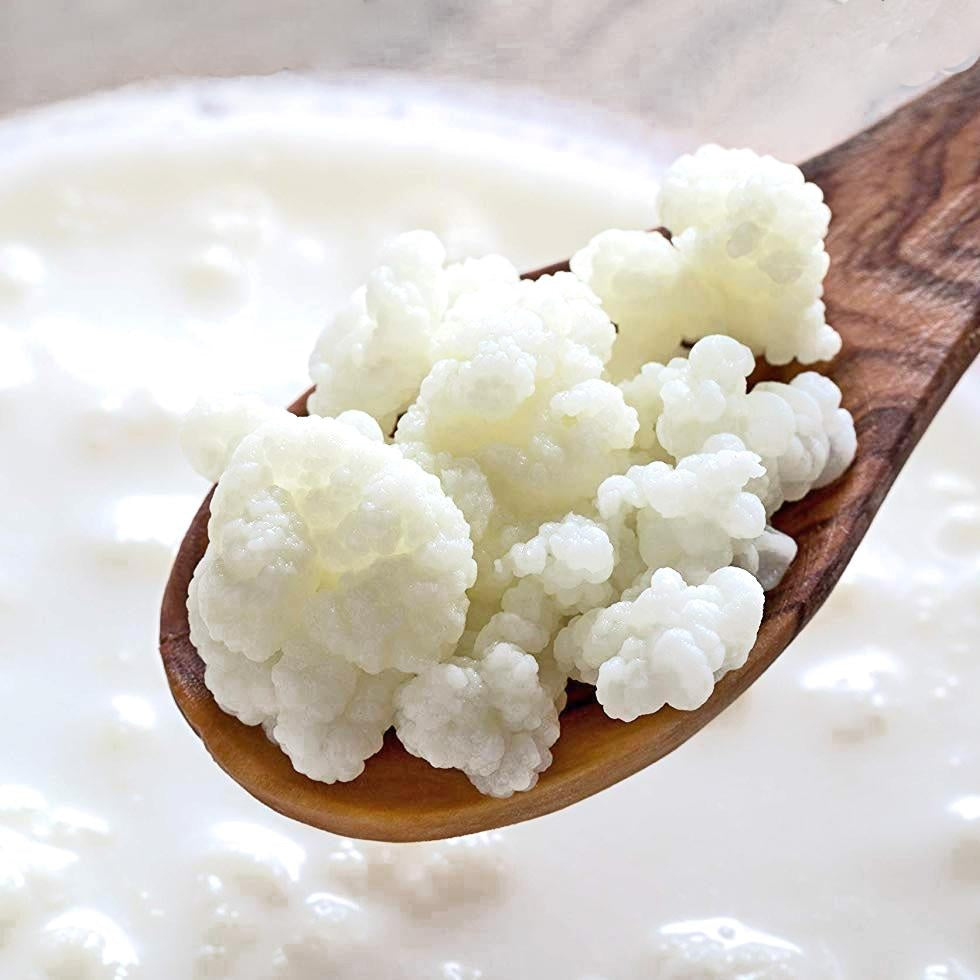
There is a huge difference in opinion in the culturing world and the scientific world on the ratio of milk kefir grains to milk.
Just to give you an idea of the different opinions:
- Dom from (users.chariot.net.au) - 1.6 tablespoons of grains per 1 cup of milk
- Kitchn.com - 1 teaspoon of grains to 1 cup of milk
- Kombucha kamp – .5 tablespoons to 1 cup of milk
- Wholenaturallife.com - 1 tablespoon to 1 cup or less
- Cultures for health –.25 teaspoons per 1 cup of milk
The consensus among home fermenters is from about .25 teaspoons per cup to 1.6 tablespoons per cup.
That’s a huge difference.
What we recommend:
For the first batch or two we tend to recommend using 1 tablespoon to 1 cup of milk just to help adjust to the new environment.
From there they can really take off and usually .5 to 1 teaspoon is enough for 1 cup depending on the environment.
That ratio gives the best flavor and texture in our opinion.
What ratio does the science think is ideal?
Peer reviewed journals measure what can be quantified.
Instead of flavor, taste and what feels right, they measure microorganism counts, grain growth, ph level, lactose level, alcohol level etc.
Those measurements are optimized with more grains and less milk. So in the scientific community, they usually deal with more grains per milk. Ratios such as 3%, 5%, 7%, 10% or even higher is common. That is basically .5 tablespoons per cup of milk to 1.6 tablespoons per cup or more.
More grains tend to create better growth, a lower ph, less lactose and more alcohol. Basically, a stronger ferment.
From a scientific standpoint, that’s optimized, but is it really?
Best Ratio for Growing Grains
For example, according to a study, a 10% ratio helps grains grow the best. It was compared against a 5%, 15% and a 20% ratio. That is 1.6 tablespoons per cup. Hardly anyone recommends that kind of ratio as it will usually taste horrible with a over-fermented texture.
Even if you wanted to grow more grains, I’m not sure if that’s ideal either. Fast grain growth through over-fermenting is never ideal for the long-term health of the grains.
Best Ratio for Probiotics
There are only two studies I can find that discusses ratio and probiotic count.
The first study tested a ratio of 3%, 5% or 7% per milk. Basically, that means .5 tablespoons of milk kefir grains per 1 cup of milk, .8 tablespoons of milk kefir grains per 1 cup of milk and 1.1 tablespoons of milk kefir grains per 1 cup of milk.
The .5 tablespoons of milk kefir grains had the highest LAC (Lactic Acid Bacteria) probiotic count and the 1.1 tablespoons of grains had the lowest!
The second study completely contradicts the first study. When the ratio increased from from 2% to 5% (more grains), the count went from 450 million CFU to 4.1 billion CFU.
Why the difference?
One reason might be that the first study only tested Lactic Acid Bacteria, while the 2nd study did a total plate count. So perhaps the LAB decreases while the total count increases.
In any case, diversity of microorganisms is better than total count.
When grains are fermented in a cool slow environment, there is a greater diversity of microorganisms.
I would suspect the same is true when you ferment with fewer grains. Less grains per milk likely means greater diversity but an overall lower count.
Bottom line
There is a great difference of opinion on what is the ideal ratio of grains to milk.
On the one hand, growth and total probiotic count seem to increase with more grains per milk. However, you may be sacrificing flavor, texture, diversity and health of the grains with too many grains per milk.
Our recommended ideal range falls somewhere in the middle of those advocating for the health of the grains and ferment.
Our recommendation for optimal flavor, texture and health (once the grains are fully active) is .5 to 1 teaspoon per cup of milk.
What is your favorite ratio of grains to milk?


Comments
mark
For a consistent, reproducible result, I now ferment using sous vide at 75°F for 24 hours using 1T grains to 1q whole milk. The grains generally come cold from the refrigerator after 1+ week storage in 2:1 milk to grains. I arrived at this after testing other time & temp combos with a pH meter targeting pH ~3.5. Result is very thick and tangy.
February 08, 2025
Michael
For those that don’t want to do the math the final recommendation is 50:1 or 100:1.
1 tsp grains per cup of milk is 2%
1/2 tsp grains per cup of milk is 1%
The studies quoted in the science section of this article used between 3% and 20%.
I like to use 100g of kefir per liter of goat’s milk. (10%) fermented for 24 hours in a closed container kept between 19C and 24C. I shake it twice during the ferment. It comes out like creamy yogurt soda. I quite like it but this article makes me curious about using fewer grains.
August 07, 2022
Sara
I got some very “strong” grains. My kitchen is around 24°C, and I’ve been used home-pasteurised milk I buy raw from the farm. I’m putting in 1/2tsp of grains to 1L of milk and it’s very very very thick after 24 hours. This seems a bit abnormal and the grains aren’t growing.
September 22, 2022
Lori felder
Hi RK REMMEN and all:
1- Do you toss out the milk you change every “2-3” days from the grains stored in fridge? Or, drink it?
2-The new grains i received from a neighbor (which i added to the half cup grains i already had) are kind of “gloppy”…that is to say, kind of pasty around each grain. Your thoughts?
3-Our summers here last for 5 months- very hot, with no air cond in kitchen. My summer ferment (where water separates from milk), happen in 8 hrs. What would you suggest to slow the progress down? I always do a double ferment, that is, place ferment #1 w/o grains back in cupboard until it separates. In my cold winter kitchen, this whole process can take up to 4 days.
Any advice is greatly appreciated. (I use raw milk, cook it correctly, then cool it in fridge overnight before starting process). Thx!
July 12, 2021
The Real McCoy
You stated: I keep almost a pint of grains in the fridge covered with milk and I change the milk every 2 or 3 days. What do you do with the milk you remove?
July 12, 2021
Sara Adam
Peace and good health greetings 🙏.
Can Kefir strains be used to make kefir in coconut milk or hemp milk or almond milk?
April 30, 2020
RK Remmen
I keep almost a pint of grains in the fridge covered with milk and I change the milk every 2 or 3 days. Every day I take a heaping T of those fridged grains per c of milk I want to culture, set the jar of cultured milk in a bowl of warm water ‘till it’s about room temp and then do a 24 hour culture. Then I return the grains I strain out to the storage jar, stir and do the aforementioned process again. So ultimately the grains in the fridge wind up being refreshed by doing a room temp culture every now and then and my grains have stayed healthy for years this way though I’m using a lot of grains per c of milk. Tastes great that way: thick and mildly sour.
March 21, 2020
Leave a comment